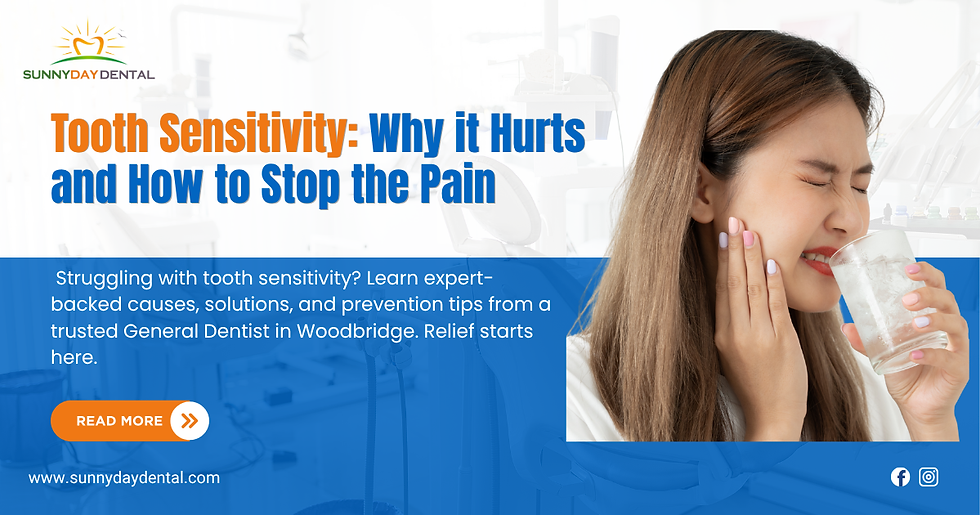Periodontitis: [4 Symptoms & How to Save Your Gums]
- Sunny Day Dental
- May 5
- 3 min read

Did you know that Periodontitis—a severe form of gum disease—is one of the leading causes of adult tooth loss? According to the Canadian Dental Association (2024), nearly 7 out of 10 adults will experience some form of gum disease in their lifetime, with Periodontitis being the most advanced and dangerous stage. The good news? It’s preventable, treatable, and manageable—if caught early.
Let’s break down what this condition really is, the four major symptoms you shouldn't ignore, and how to take action—whether through regular care or by visiting an emergency dental clinic in Woodbridge—before it’s too late.
What is Periodontitis?
Periodontitis is an inflammatory disease that affects the gums and supporting structures of the teeth. It starts off as gingivitis, a mild irritation of the gums, and if untreated, it escalates to Periodontitis—causing permanent damage to the soft tissue and bone holding your teeth in place.
4 Symptoms of Periodontitis You Should Never Ignore
1. Persistent Bad Breath (Halitosis)
Chronic bad breath that doesn’t go away with brushing or mouthwash can be a telltale sign of Periodontitis. The infection creates bacteria-laden pockets in your gums, releasing unpleasant odors.
2. Bleeding Gums
While a little bleeding might seem harmless, especially when brushing or flossing, this is often the first sign of gum disease and Periodontitis. Healthy gums don’t bleed!
3. Receding Gums
Do your teeth appear longer than before? Gum recession is a major red flag. It exposes the roots, making your teeth sensitive and vulnerable to decay.
4. Loose or Shifting Teeth
As Periodontitis progresses, the bone supporting your teeth starts to deteriorate. This can cause teeth to become loose or move out of alignment—requiring urgent Periodontitis treatment.
How to Save Your Gums: A Step-by-Step Guide?
Step 1: Get a Professional Diagnosis
Visit your dentist for a comprehensive periodontal evaluation. At Sunny Day Dental, we use digital imaging and probing to assess gum pocket depth and bone loss.
Step 2: Deep Cleaning (Scaling & Root Planing)
This non-surgical treatment removes plaque and tartar from beneath the gum line and smoothens root surfaces, helping gums reattach to teeth.
Step 3: Targeted Medications
Topical antibiotics or antiseptic chips may be placed directly into the gum pockets to control bacterial infection and inflammation.
Step 4: Surgical Options (If Necessary)
If non-invasive methods aren't enough, oral surgery in Woodbridge—like flap surgery or bone grafting—may be required to restore gum health.
Step 5: Maintain Daily Oral Hygiene
Brush twice a day with fluoride toothpaste, floss daily, and use a therapeutic mouthwash. Avoid smoking—it doubles your risk of developing Periodontitis.
Quick Tips to Prevent Periodontitis
Brush & floss daily
Schedule cleanings twice a year
Avoid smoking and sugary foods
Treat gingivitis early
Know your family history
Trusted Periodontitis Treatment at Sunny Day Dental, Woodbridge
If you're experiencing symptoms of Periodontitis, don’t wait. Sunny Day Dental is your go-to emergency dental clinic in Woodbridge—equipped with modern diagnostic tools, gentle care techniques, and personalized treatment plans. Whether you need preventive care or advanced oral surgery in Woodbridge, our experienced dental team is here to save your gums and restore your smile.
FAQ: Periodontitis – Your Questions Answered
1. Can Periodontitis go away on its own?
No. Periodontitis requires professional treatment. Ignoring it can lead to tooth loss and other health problems like heart disease.
2. Is Periodontitis painful?
It can be—but not always in the early stages. That’s why routine dental visits are crucial, even if you're not experiencing discomfort.
3. How is Periodontitis different from gingivitis?
Gingivitis is the mild, reversible stage of gum disease. Periodontitis is its advanced form, involving permanent bone and tissue damage.
4. Can children get Periodontitis?
Though rare, children and teens can develop aggressive forms of the disease, especially if oral hygiene is poor or they have underlying conditions.
5. What foods should I avoid with Periodontitis?
Sticky sweets, hard snacks, and sugary drinks can worsen gum issues. Opt for soft, high-fiber foods like fruits, vegetables, and yogurt.




Comments